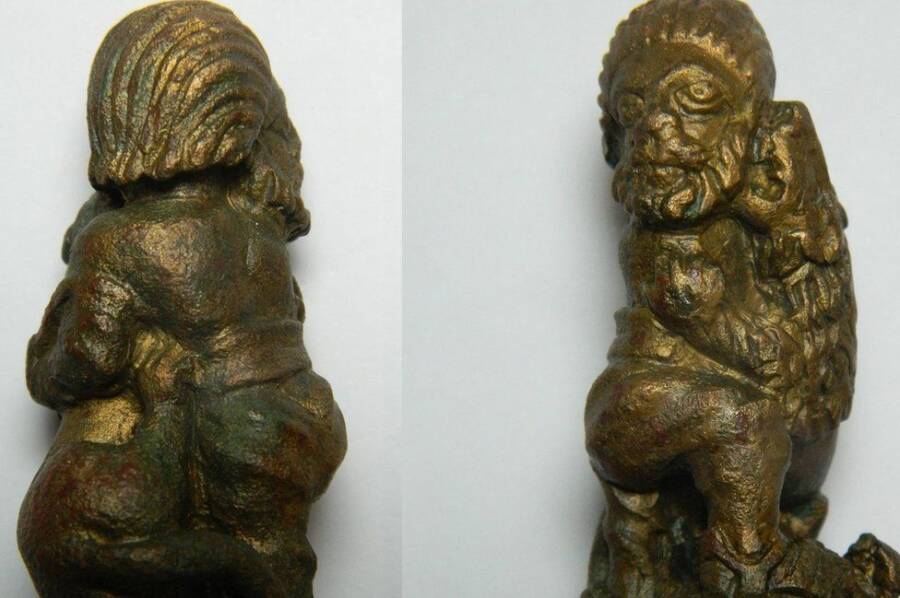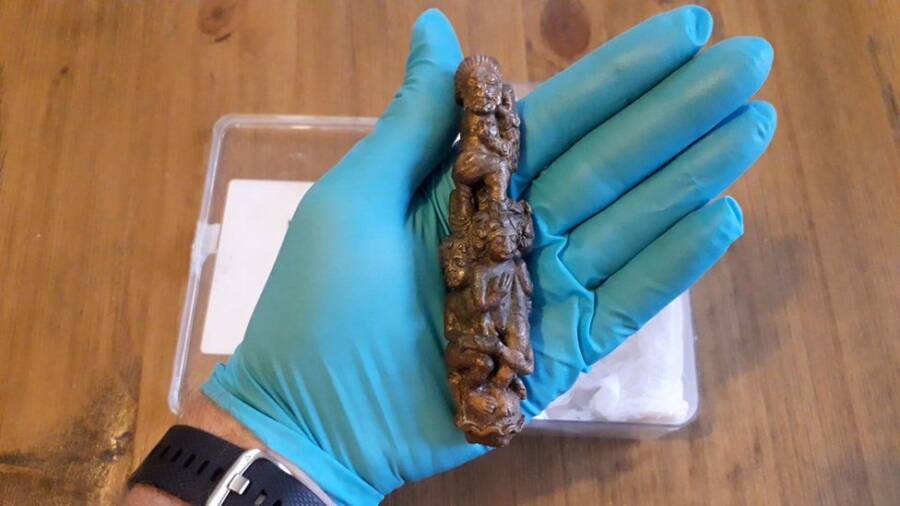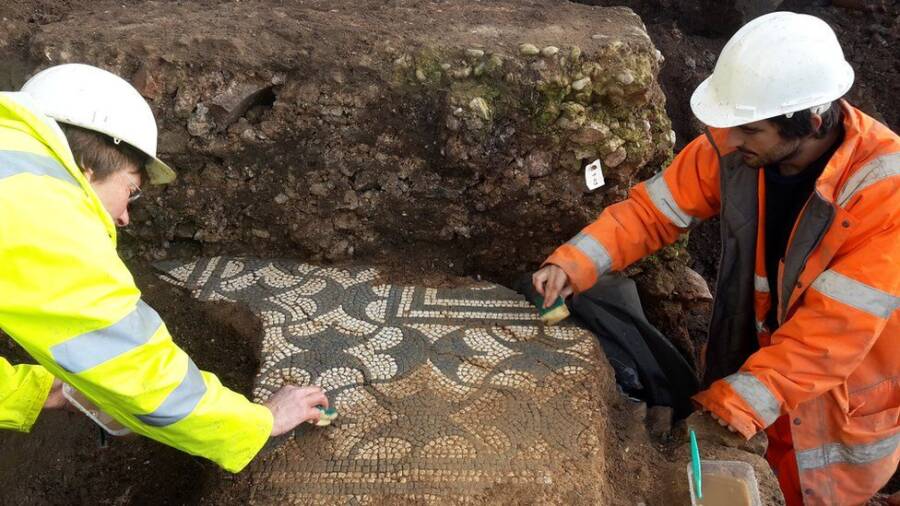The key handle was found at an excavation in Leicester and depicts a scraggly-haired man being devoured by a lion.

University of LeicesterLead excavator Dr. Gavin Speed said that nothing like this has ever been found “anywhere in the Roman Empire before.”
Despite falling nearly 1,600 years ago, the Roman Empire was so dominant and expansive that relics of its reign keep surfacing today. Discovered only five years ago in Leicester, England, a bronze key handle has now shed light on how ruthless that reign really was — as it depicts lions being used in human executions in Roman Britain.
Unearthed from a Roman townhouse by Dr. Gavin Speed, of the University of Leicester, the artifact initially appeared to be nothing but a vague clump of bronze. According to the BBC, rigorous study at King’s College London has now revealed its detailed depiction of a “Barbarian” fighting a lion and four boys recoiling in fear.
“When first found, it appeared as an indistinguishable bronze object, but after we carefully cleaned off the soil remarkably we revealed several small faces looking back at us, it was absolutely astounding,” said Dr. Speed. “Nothing quite like this has been discovered anywhere in the Roman Empire before.”
It’s no secret that Rome used wild animals to execute criminals and prisoners of war. This form of spectacle was known as damnatio ad bestias and relegated the Colosseum to bloody infamy ever since.
Finding evidence of this grisly discipline as far as Britain, however, was unprecedented.

University of LeicesterThe key handle during excavations between 2016 and 2017.
Excavations by the University of Leicester Archaeological Services (ULAS) began in 2016 and lasted a year. They were led by Dr. Speed, and took researchers to a former Roman site off Great Central Street about a mile and half from the university itself. Published in the Britannia journal, the subsequent study is unrivaled.
“This unique object gives us our most detailed representation of this form of execution found in Roman Britain,” said co-author Dr. John Pearce, of King’s College. “As the first discovery of this kind, it illuminates the brutal character of Roman authority in this province.”
It was only after securing the item and careful cleaning, however, that the research team even realized what lay beneath the dirt. A copper-alloy key handle, it was decorated with a bearded, unarmed man about to be devoured by a ferocious lion — and four terrified youths embracing each other below.
Intriguingly, it appeared to mirror the sanctioned executions regularly organized at the heart of the Roman Empire. Arenas like the Colosseum would host “games” for public viewing, in which unfortunate participants symbolized the “barbarian” enemies of Rome — who would be decimated by animals to universal cheers.

University of LeicesterThe key handle upon rigorous cleaning at King’s College London.
Aside from a male skeleton found punctured by a large carnivore in York, evidence that these gruesome spectacles even occurred in Roman Britain has been practically nonexistent. The bronze key handle has thus left experts in awe.
The study posited that the four youths observing symbolized the “children of the tribe.” One appeared to hold a stone, while their presence was meant to suggest that they were next in line to die. The key handle is thus just another stern reminder by Roman authority that any opposition would be dealt with.
Curiously, the find followed the recent excavation of a Roman theater in Leicester. While many towns in Britain once held similar theaters and arenas, this particular venue was found next door to the townhouse holding the key handle. Ultimately, the object might have been inspired by executions mere feet away.
“It’s one of the most exciting finds we’ve had in Roman Leicester, and it’s got a great story to tell about life in Roman Leicester and the potential evidence it gives for activities that might have taken place in the theater, or possibly an amphitheater that we haven’t discovered yet,” said Nick Cooper, of the ULAS.

University of LeicesterThe Roman theater and its mosaic flooring discovered next door.
Researchers believe that the object was made at least one century after Rome conquered Britain, with its owner likely fearing enemy tribes that their ancestors were once considered part of. Remarkably, the item was found upright within the flooring — perhaps positioned as a totem of protection.
Ultimately, the key handle is still in the process of refurbishment. Following completion in 2023, it will be displayed at the Jewry Wall Museum in Leicester — a modern-day town that once potentially saw wild beasts execute human beings for the entertainment of thousands.
After reading about the Roman key handle suggesting lions were used in human executions in Britain, learn about the 2,000-year-old Roman gladiator arena uncovered in Turkey. Then, read about the high number of decapitated bodies found at a Roman burial site in England.





